Heinrich J.G., Aldinger F. (Eds.) Ceramic Materials and Components for Engines
Подождите немного. Документ загружается.


This Page Intentionally Left Blank
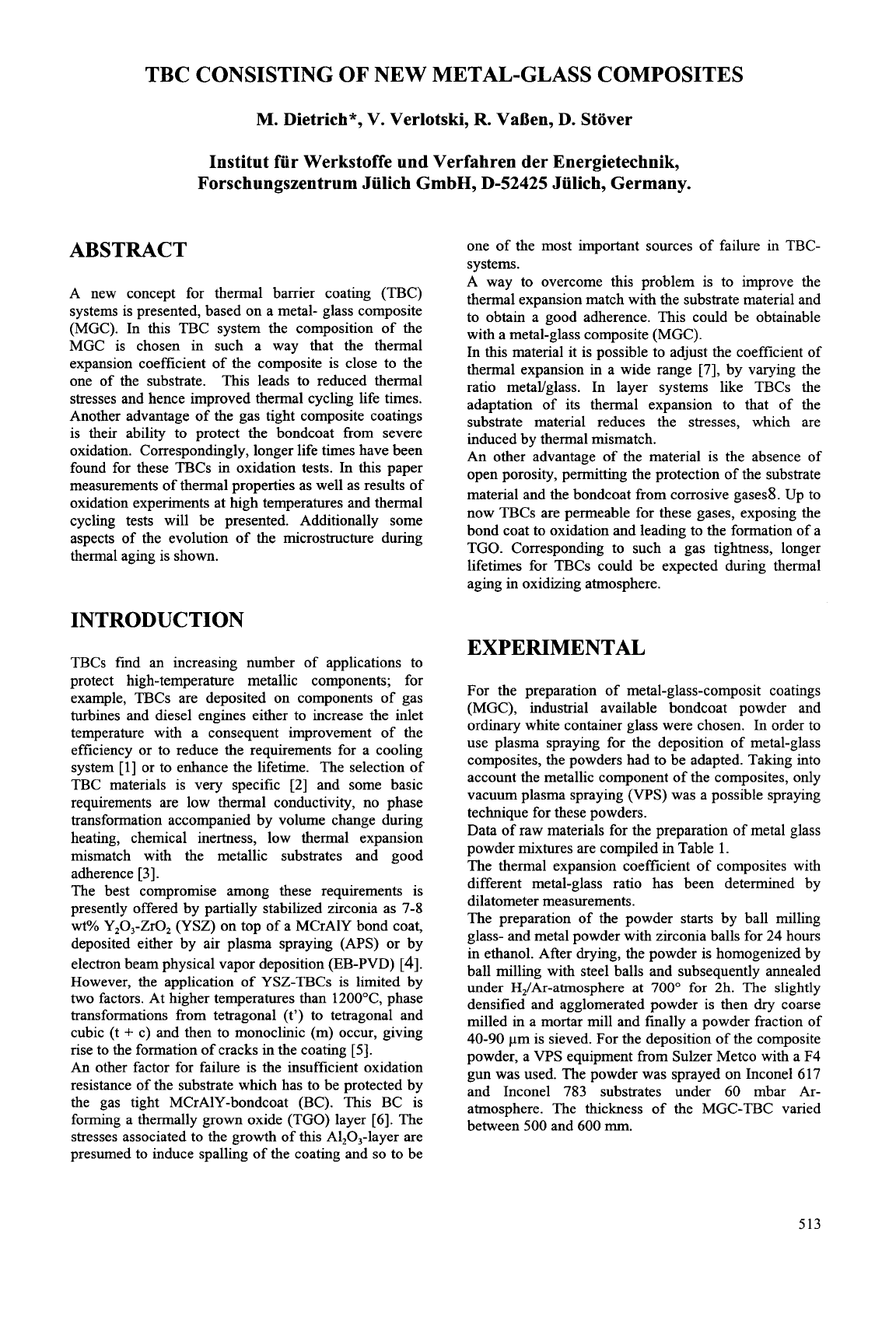
TBC CONSISTING
OF
NEW METAL-GLASS COMPOSITES
M. Dietrich*, V. Verlotski,
R.
VaDen, D. Stover
Institut fur Werkstoffe und Verfahren der Energietechnik,
Forschungszentrum Jiilich GmbH,
D-52425
Jiilich, Germany.
ABSTRACT
A new concept for thermal barrier coating (TBC)
systems is presented, based on a metal- glass composite
(MGC). In this TBC system the composition of the
MGC is chosen in such a way that the thermal
expansion coefficient of the composite is close to the
one of the substrate. This leads to reduced thermal
stresses and hence improved thermal cycling life times.
Another advantage of the gas tight composite coatings
is their ability to protect the bondcoat from severe
oxidation. Correspondingly, longer life times have been
found for these
TBCs
in oxidation tests. In this paper
measurements of thermal properties as well as results of
oxidation experiments at high temperatures and thermal
cycling tests will be presented. Additionally some
aspects of the evolution of the microstructure during
thermal aging is shown.
INTRODUCTION
TBCs find an increasing number of applications to
protect high-temperature metallic components; for
example, TBCs are deposited on components of gas
turbines and diesel engines either to increase the inlet
temperature with a consequent improvement of the
efficiency or to reduce the requirements for a cooling
system [l] or to enhance the lifetime. The selection of
TBC materials is very specific [2] and some basic
requirements are low thermal conductivity, no phase
transformation accompanied by volume change during
heating, chemical inertness, low thermal expansion
mismatch with the metallic substrates and good
adherence [3].
The best compromise among these requirements is
presently offered by partially stabilized zirconia as
7-8
wt% Y,O,-ZrO, (YSZ) on top of a MCrAlY bond coat,
deposited either by air plasma spraying (APS) or by
electron beam physical vapor deposition (EB-PVD)
[4].
However, the application
of
YSZ-TBCs is limited by
two
factors. At higher temperatures than
1200"C,
phase
transformations from tetragonal (t') to tetragonal and
cubic (t
+
c) and then to monoclinic (m) occur, giving
rise to the formation of cracks in the coating
[5].
An other factor for failure is the insufficient oxidation
resistance of the substrate which has to be protected by
the gas tight MCrAlY-bondcoat (BC). This BC is
forming a thermally grown oxide (TGO) layer [6]. The
stresses associated to the growth of this Al,O,-layer are
presumed to induce spalling of the coating and
so
to be
one
of
the most important sources of failure in TBC-
systems.
A way to overcome this problem is to improve the
thermal expansion match with the substrate material and
to obtain a good adherence. This could be obtainable
with a metal-glass composite (MGC).
In this material it is possible to adjust the coefficient of
thermal expansion in a wide range [7], by varying the
ratio metayglass. In layer systems like TBCs the
adaptation of its thermal expansion to that of the
substrate material reduces the stresses, which are
induced by thermal mismatch.
An other advantage of the material is the absence of
open porosity, permitting the protection of the substrate
material and the bondcoat from corrosive gases8. Up to
now
TBCs
are permeable for these gases, exposing the
bond coat to oxidation and leading to the formation of a
TGO. Corresponding to such a gas tightness, longer
lifetimes for TBCs could be expected during thermal
aging in oxidizing atmosphere.
EXPERIMENTAL
For the preparation of metal-glass-composit coatings
(MGC), industrial available bondcoat powder and
ordinary white container glass were chosen. In order to
use plasma spraying for the deposition of metal-glass
composites, the powders had to be adapted. Taking into
account the metallic component of the composites, only
vacuum plasma spraying
(VPS)
was a possible spraying
technique for these powders.
Data of raw materials for the preparation of metal glass
powder mixtures are compiled in Table 1.
The thermal expansion coefficient of composites with
different metal-glass ratio has been determined by
dilatometer measurements.
The preparation of the powder starts by ball milling
glass- and metal powder with zirconia balls for 24 hours
in ethanol. After drying, the powder is homogenized by
ball milling with steel balls and subsequently annealed
under HJAr-atmosphere at
700"
for 2h.
The
slightly
densified and agglomerated powder is then dry coarse
milled in a mortar mill and finally a powder fraction of
40-90 pm is sieved. For the deposition of the composite
powder, a VPS equipment from Sulzer Metco with a F4
gun was used. The powder was sprayed on Inconel 617
and Inconel 783 substrates under 60 mbar Ar-
atmosphere. The thickness of the MGC-TBC varied
between
500
and 600
nun.
513
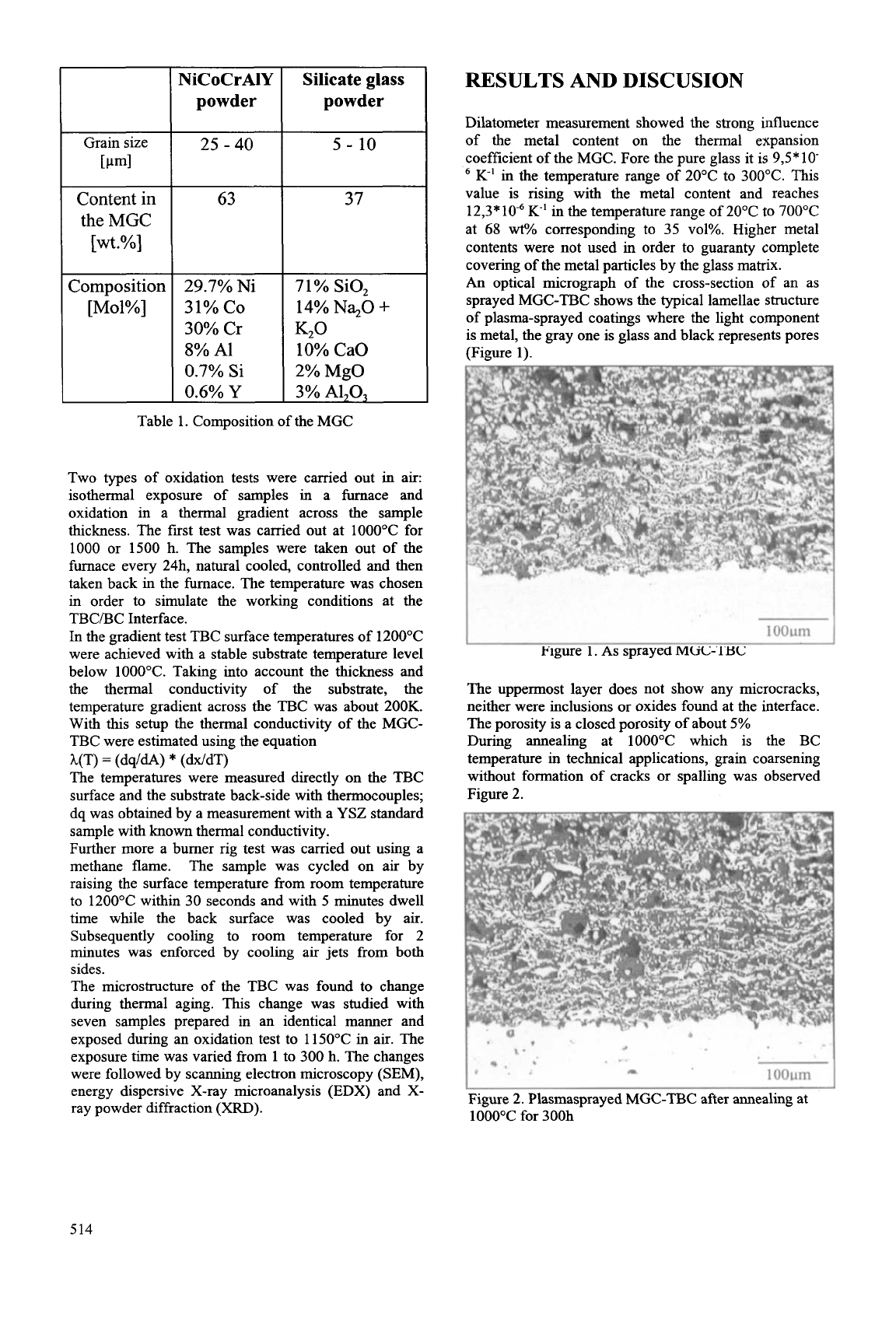
I
NiCoCrAlY
I
Silicate glass
I
Grain size
powder powder
25
-
40
5
-
10
Content in
I
63
theMGC
I
37
[wt.%]
I
Composition
[MolYo]
29.7% Ni
31% Co
30%
Cr
0.7%
si
8%
A1
71% SO2
14%
NqO
+
K20
10% CaO
Table 1. Composition of the MGC
Two types of oxidation tests were carried out in air
isothermal exposure of samples in a furnace and
oxidation in a thermal gradient across the sample
thickness. The first test was carried out at 1000°C for
1000 or 1500 h. The samples were taken out of the
furnace every 24h, natural cooled, controlled and then
taken back
in
the furnace. The temperature was chosen
in order to simulate the working conditions at the
TBC/BC Interface.
In the gradient test TBC surface temperatures of 1200°C
were achieved with a stable substrate temperature level
below 1000°C. Taking into account the thickness and
the thermal conductivity of the substrate, the
temperature gradient across the TBC was about 200K.
With this setup the thermal conductivity of the MGC-
TBC were estimated using the equation
h(T)
=
(dq/dA)
*
(dx/dT)
The temperatures were measured directly on the TBC
surface and the substrate back-side with thermocouples;
dq was obtained by a measurement with a
YSZ
standard
sample with
known
thermal conductivity.
Further more a burner rig test was carried out using a
methane flame. The sample was cycled on air by
raising the surface temperature from room temperature
to 1200°C within
30
seconds and with
5
minutes dwell
time while the back surface was cooled by air.
Subsequently cooling to room temperature for 2
minutes was enforced by cooling air jets from
both
sides.
The microstructure of the TBC was found to change
during thermal aging. This change was studied with
seven samples prepared in an identical manner and
exposed during an oxidation test to 1150°C in air. The
exposure time was varied from 1 to 300 h. The changes
were followed by scanning electron microscopy (SEM),
energy dispersive X-ray microanalysis
(EDX)
and X-
ray powder diffraction (XRD).
RESULTS AND DISCUSION
Dilatometer measurement showed the strong influence
of the metal content on the thermal expansion
coefficient of the MGC. Fore the pure glass it is
9,5*
10-
K-' in the temperature range of 20°C to 300°C. This
value is rising with the metal content and reaches
12,3*10-6
K-'
in
the temperature range of 20°C
to
7OOOC
at
68
wt%
corresponding to
35
~01%. Higher metal
contents were not used in order to guaranty complete
covering of the metal particles by the glass matrix.
An optical micrograph of the cross-section of an as
sprayed MGC-TBC shows the typical lamellae structure
of plasma-sprayed coatings where the light component
is metal, the gray one is glass and black represents pores
(Figure 1).
I
1
ooum
I
Figure 1. As sprayed MGC-TBC
The uppermost layer does not show any microcracks,
neither were inclusions or oxides found at the interface.
The porosity is a closed porosity of about
5%
During annealing at 1000°C which is the BC
temperature in technical applications, grain coarsening
without formation of cracks or spalling was observed
Figure 2.
s
**
1
Ohm
Figure 2. Plasmasprayed MGC-TBC after annealing at
1000°C for 300h
*r
*'
'
1
.d
5
14
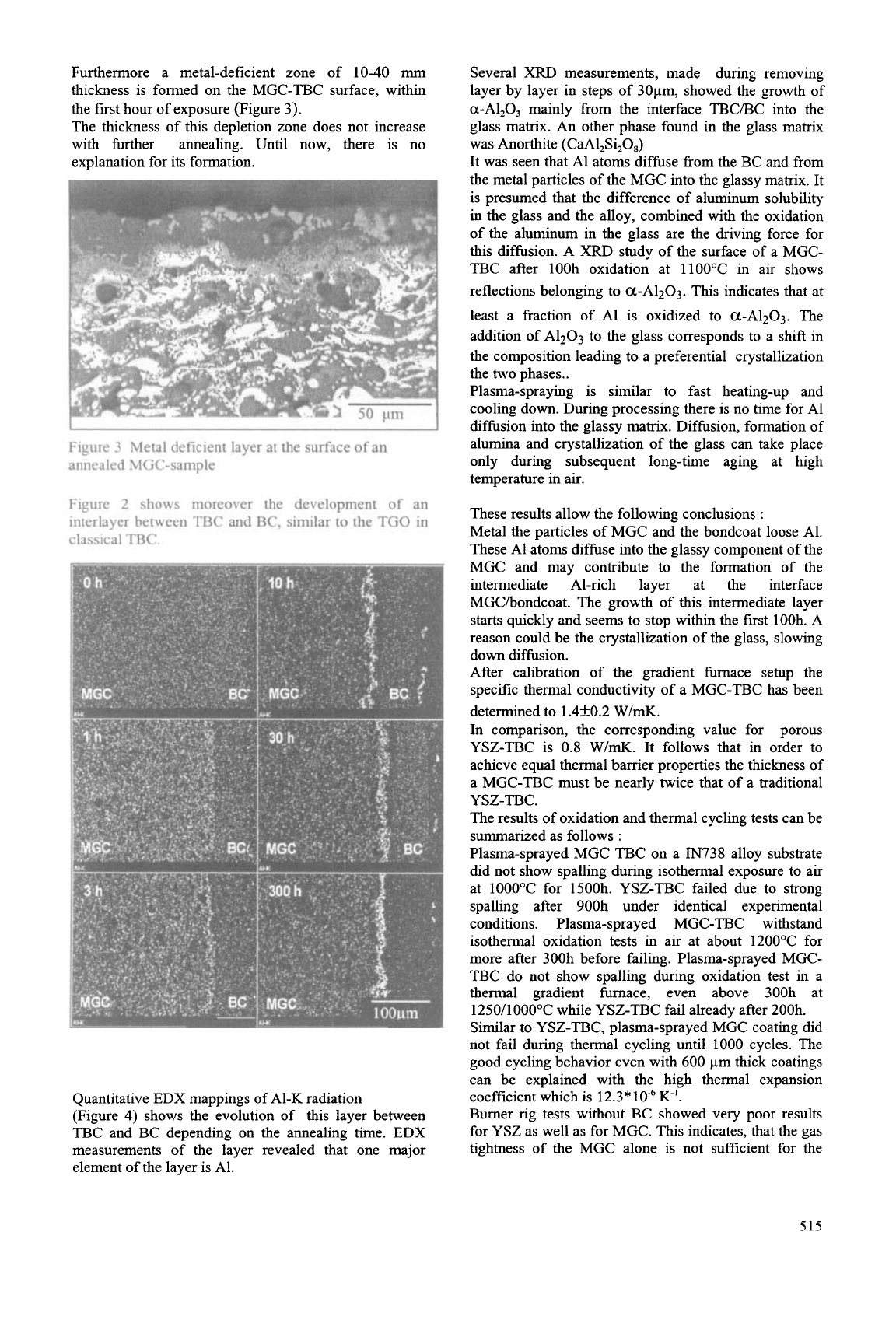
Furthermore a metal-deficient zone of 10-40
mm
Several
XRD
measurements, made during removing
thickness is formed on the MGC-TBC surface, within
layer by layer in steps of 30pm, showed the growth of
the
first
hour of exposure (Figure 3).
a-Al,O, mainly from the interface TBC/BC into the
The thickness of this depletion zone does not increase glass matrix. An other phase found in the glass matrix
with further annealing. Until now, there is no was Anorthite (CaAl,Si,O,)
explanation for its formation.
It was seen that A1 atoms diffuse from the BC and from
the metal particles of the MGC into the glassy matrix. It
is presumed that the difference of aluminum solubility
in the glass and the alloy, combined with the oxidation
of the aluminum in the glass are the driving force for
this diffusion. A
XRD
study of the surface of a MGC-
TBC after lOOh oxidation at 1100°C in air shows
reflections belonging to a-AlzO3. This indicates that at
least a fraction of A1 is oxidized to a-Al203. The
addition of A1203 to the glass corresponds to a shift in
the composition leading to a preferential crystallization
the two phases..
Plasma-spraying is similar to fast heating-up and
cooling down. During processing there is no time for A1
diffusion into the glassy matrix. Diffusion, formation of
Figure 3 Metal deficient layer at the surface of an
annealed MGC-sample
alumina and crystallization of the glass can take place
only during subsequent long-time aging at high
temperature in air.
--
MGC and may contribute to the formation of the
intermediate Al-rich layer at the interface
MGC/bondcoat. The growth of this intermediate layer
starts quickly and seems to stop within the first 100h.
A
reason could be the crystallization of the glass, slowing
down diffusion.
After calibration of the gradient furnace setup the
specific thermal conductivity of a MGC-TBC has been
determined to 1.4f0.2
W/mK.
In
comparison, the corresponding value for porous
YSZ-TBC is 0.8
W/mK.
It
follows that in order to
achieve equal thermal barrier properties the thickness of
a MGC-TBC must be nearly twice that of a traditional
The results of oxidation and thermal cycling tests can be
summarized as follows
:
Plasma-sprayed MGC TBC on a IN738 alloy substrate
did not show spalling during isothermal exposure to air
at 1000°C for 1500h. YSZ-TBC failed due to strong
spalling after 900h under identical experimental
conditions. Plasma-sprayed MGC-TBC withstand
isothermal oxidation tests
in
air at about 1200°C for
more after 300h before failing. Plasma-sprayed MGC-
TBC do not show spalling during oxidation test in
a
thermal gradient furnace, even above
300h
at
1250/1O0O0C while YSZ-TBC fail already after 200h.
Similar to YSZ-TBC, plasma-sprayed MGC coating did
Y SZ-TBC.
Figure
4.
A1
Ka
X-mapping of annealed MGC-TBC:
Evolution of tne interlayer between TBC and BC
Quantitative EDX mappings of A1-K radiation
(Figure
4)
shows the evolution of this layer between
TBC and BC depending on the annealing time. EDX
measurements of the layer revealed that one major
element of the layer is Al.
not fail during ther&al cycling until
1000
cycles-The
good cycling behavior even with
600
pm thick coatings
can be explained with the high thermal expansion
coefficient which is 12.3*10-6
K-'.
Burner rig tests without BC showed very poor results
for YSZ as well as for MGC. This indicates, that the gas
tightness of the MGC alone is not sufficient for the
515
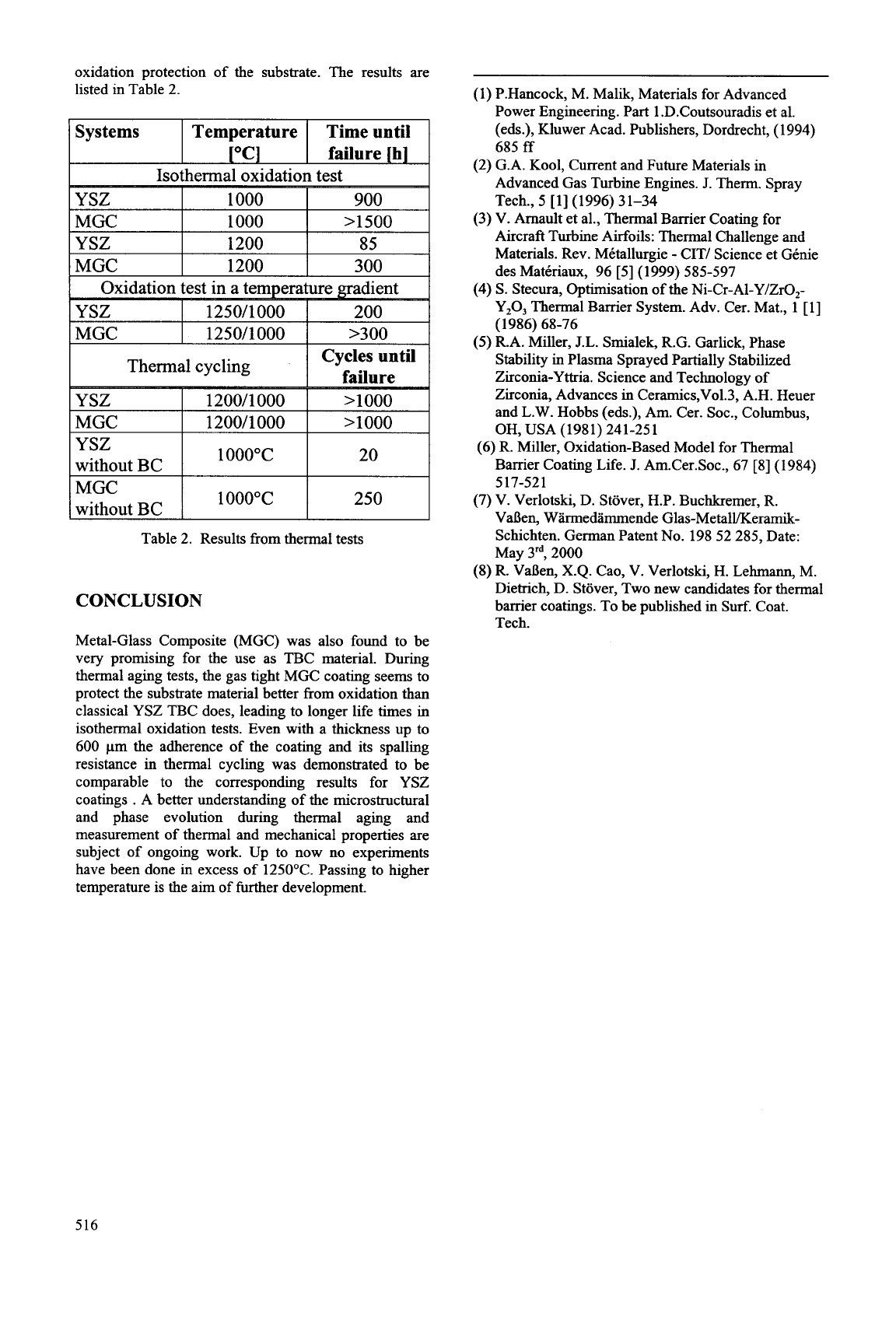
oxidation protection of the substrate. The results are
listed in Table
2.
YSZ
MGC
YSZ
MGC
1000
900
1000 >1500
1200 85
1200
300
MGC
YSZ
without
BC
1200/1000 >loo0
1
ooooc
20
Table 2. Results from thermal tests
1
ooooc
MGC
without BC
CONCLUSION
250
Metal-Glass Composite (MGC) was also found to be
very promising for the use as
TBC
material. During
thermal aging tests, the gas tight MGC coating seems to
protect the substrate material better from oxidation than
classical YSZ TBC does, leading to longer life times in
isothermal oxidation tests. Even with a thickness up to
600 pm the adherence of the coating and its spalling
resistance in thermal cycling was demonstrated to be
comparable to the corresponding results for YSZ
coatings
.
A better understanding of the microstructural
and phase evolution during thermal aging and
measurement of thermal and mechanical properties are
subject of ongoing work. Up to now no experiments
have been done
in
excess of 1250OC. Passing to higher
temperature is the aim of further development.
(1) P.Hancock, M. Malik, Materials for Advanced
Power Engineering. Part 1 .D.Coutsouradis et al.
(eds.), Kluwer Acad. Publishers, Dordrecht, (1994)
685
ff
Advanced Gas Turbine Engines.
J.
Therm. Spray
Tech.,
5
[l] (1996)
31-34
Aircraft Turbine Airfoils: Thermal Challenge and
Materials. Rev. MCtallurgie
-
CITI Science et GCnie
des MatCriaux, 96 [5] (1999) 585-597
Y203 Thermal Barrier System. Adv. Cer. Mat., 1
[
11
(1986) 68-76
(5) R.A. Miller,
J.L.
Smialek, R.G. Garlick, Phase
Stability in Plasma Sprayed Partially Stabilized
Zirconia-Yttria. Science and Technology of
Zirconia, Advances in Ceramics,Vol.3, A.H. Heuer
and L.W. Hobbs (eds.), Am. Cer. SOC., Columbus,
(2) G.A. Kool, Current and Future Materials in
(3) V. Arnault et al., Thermal Barrier Coating for
(4)
S.
Stecura, Optimisation of the Ni-Cr-Al-Y/ZrO,-
OH, USA (1981) 241-251
(6) R. Miller, Oxidation-Based Model for Thermal
Bamer Coating Life.
J.
Am.Cer.Soc., 67 [8] (1984)
517-521
(7) V. Verlotski, D. Stover, H.P. Buchkremer,
R.
VaBen, Warmedtimmende Glas-MetalVKeramik-
Schichten. German Patent No. 198 52 285, Date:
May 3rd, 2000
(8) R. VaBen,
X.Q.
Cao, V. Verlotski, H. Lehmann, M.
Dietrich, D. Stover, Two new candidates for thermal
barrier coatings. To be published in
Surf.
Coat.
Tech.
516
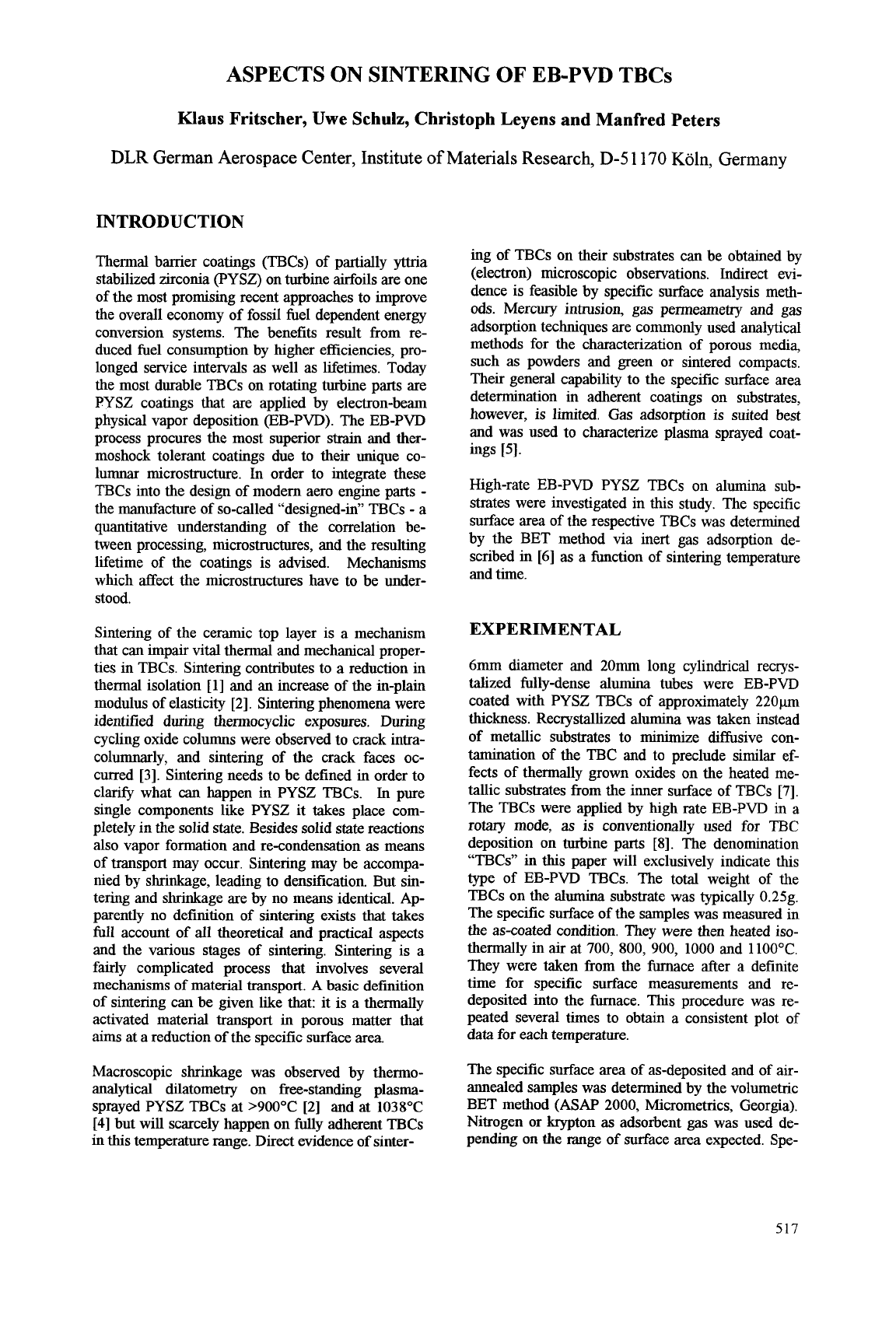
ASPECTS ON SINTERING
OF
EB-PVD TBCS
Klaus Fritscher, Uwe Schulz, Christoph Leyens and Manfred Peters
DLR
German Aerospace Center, Institute
of
Materials Research,
D-5
1
170
Koln, Germany
INTRODUCTION
Thermal barrier coatings
(TBCs)
of partially yttria
stabilized zirconia (PYSZ) on turbine airfoils are one
of the most promising recent approaches to improve
the overall economy of fossil fuel dependent energy
conversion systems. The benefits result from re-
duced fuel consumption by higher efficiencies, pro-
longed service intervals as well as lifetimes. Today
the most durable
TBCs
on rotating turbine parts are
PYSZ coatings that are applied by electron-beam
physical vapor deposition (EB-PVD). The EB-PVD
process procures the most superior
strain
and
ther-
moshock tolerant coatings due to their unique co-
lumnar microstructure.
In
order to integrate these
TBCs into the design of modem aero engine parts
-
the manufacture of so-called “designed-$
TBCs
-
a
quantitative understanding of the correlation be-
tween processing, microstructures, and the resulting
lifetime of the coatings is advised. Mechanisms
which affect the microstructures have to be under-
stood.
Sintering of the ceramic top layer is a mechanism
that can impair vital thermal and mechanical proper-
ties in TBCs. Sintering contributes to a reduction in
thermal isolation [l] and an increase of the in-plain
modulus of elasticity [2]. Sintering phenomena were
identified during thermocyclic exposures. During
cycling oxide columns were observed to crack intra-
columnarly, and sintering of the crack faces oc-
curred [3]. Sintering needs to be defined in order to
clanfy what
can
happen in PYSZ
TBCs.
In
pure
single components like PYSZ it takes place com-
pletely in the solid state. Besides solid state reactions
also vapor formation and re-condensation as means
of
transport may occur. Sintering may be accompa-
nied by shrinkage, leading to densification. But sin-
tering and shrinkage are by no means identical. Ap-
parently no definition of sintering exists that takes
full account of all theoretical and practical aspects
and the various stages of sintering. Sintering is a
fairly complicated process that involves several
mechanisms of material transport.
A
basic definition
of
sintering can be given like that: it is a thermally
activated material transport in porous matter that
aims at a reduction of the specific surface
area.
Macroscopic shrinkage was observed by thermo-
analytical dilatometry on free-standing plasma-
sprayed PYSZ
TBCs
at
>9OO0C
[2] and
at
1038°C
[4]
but will scarcely happen on
fully
adherent
TBCs
in
this
temperature range. Direct evidence
of
sinter-
ing of
TBCs
on their substrates can be obtained by
(electron) microscopic observations. Indnect evi-
dence is feasible by specific surface analysis meth-
ods. Mercury intrusion,
gas
permeametry and gas
adsorption techniques are commonly used analytical
methods for the characterization of porous media,
such as powders and green or sintered compacts.
Their general capability to the specific surface area
determination in adherent coatings on substrates,
however, is limited. Gas adsorption
is
suited best
and was used to characterize plasma sprayed coat-
ings
[
51.
High-rate EB-PVD PYSZ
TBCs
on alumina sub-
strates were investigated in this study. The specific
surface area of the respective TBCs was determined
by the BET method via inert gas adsorption de-
scribed in [6]
as
a function of sintering temperature
and time.
EXPERIMENTAL
6mm Qameter and 20mm long cylindrical recrys-
talized fully-dense alumina tubes were EB-PVD
coated with PYSZ
TBCs
of approximately 220pm
thickness. Recrystallized alumina was taken instead
of metallic substrates to minimize diffusive con-
tamination of the
TBC
and to preclude similar ef-
fects of thermally grown oxides on the heated me-
tallic substrates from the inner surface
of
TBCs
[7].
The TBCs were applied by high rate EB-PVD in a
rotary mode, as
is
conventionally used for
TBC
deposition on turbine parts [8]. The denomination
“TBCs”
in
th~s
paper will exclusively indicate
this
type of EB-PVD
TBCs.
The total weight
of
the
TBCs
on the alumina substrate was typically
0.25g.
The specific surface
of
the samples was measured in
the as-coated condition. They were then heated iso-
thermally in air at
700,
800,
900,
1000 and 1100°C.
They were taken from the furnace after a definite
time for specific surface measurements and re-
deposited into the furnace.
This
procedure was re-
peated several times to obtain a consistent plot
of
data for each temperature.
The specific surface area of as-deposited and of air-
annealed samples was determined by the volumetric
BET method
(ASAP
2000,
Micrometrics, Georgia).
Nitrogen or krypton
as
adsorbent
gas
was used de-
pending on the range
of
surface area expected. Spe-
517
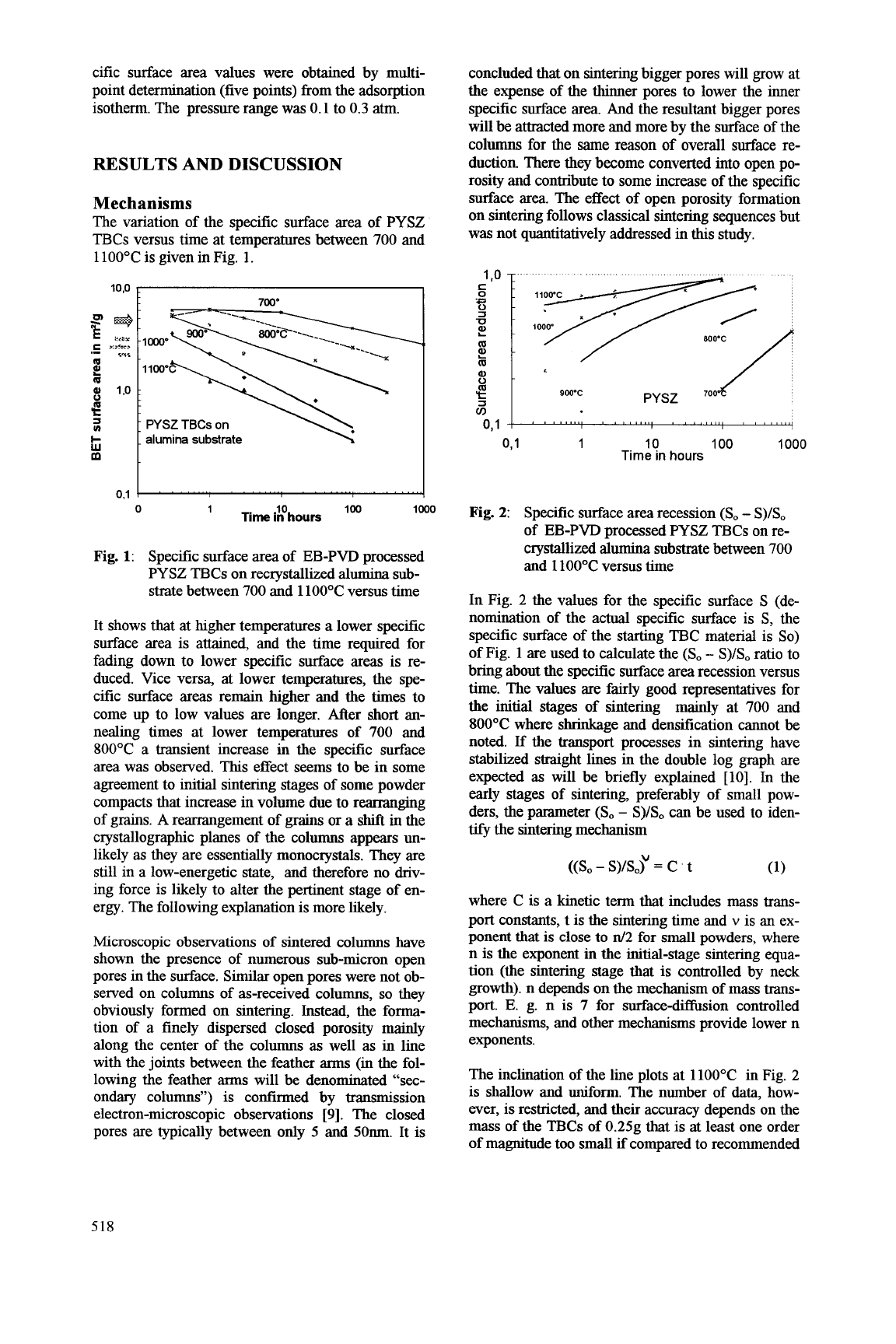
cific surface area values were obtained by multi-
point determination (five points) from the adsorption
isotherm. The pressure range was 0.1 to
0.3
atm.
RESULTS AND DISCUSSION
Mechanisms
The variation of the specific surface area
of
PYSZ
TBCs versus time at temperatures between
700
and
1100°C is given in Fig.
1.
concluded that on sintering bigger pores will grow at
the expense of the thinner pores to lower the inner
specific surface area. And the resultant bigger pores
will be attracted more and more by the surface of the
columns for the same reason of overall surface re-
duction. There they become converted into open po-
rosity
and
contribute to some increase of the specific
surface area. The effect of open porosity formation
on sintering follows classical sintering sequences but
was not quantitatively addressed in this study.
700"
PYSZ
TBCs
on
alumina substrate
1
10 100
Time
in
hours
1000
Fig.
1:
Specific surface area of EB-PVD processed
PYSZ TBCs on recrystallized alumina
sub-
strate between
700
and
1
100°C versus time
It shows that at higher temperatures a lower specific
surface area is attained, and the time required for
fading down to lower specific surface areas is re-
duced. Vice versa, at lower temperatures, the spe-
cific surface areas remain higher and the times to
come up to low values are longer. After short
an-
nealing times at lower temperatures of
700
and
800OC a transient increase in the specific surface
area was observed.
This
effect seems to be in some
agreement to initial sintering stages of some powder
compacts that increase in volume due to rearranging
of
grains.
A
rearrangement of
grains
or a
shift
in the
crystallographic planes of the columns appears
un-
likely
as
they are essentially monocrystals. They are
still in a low-energetic state, and therefore no driv-
ing force is likely to alter the pertinent stage of en-
ergy. The following explanation is more likely.
Microscopic observations of sintered columns have
shown the presence of numerous sub-micron open
pores in the surface. Similar open pores were not ob-
served on columns of as-received columns,
so
they
obviously formed on sintering.
Instead,
the forma-
tion of a finely dispersed closed porosity mainly
along the center of the columns
as
well as in line
with the joints between the feather
arms
(in the fol-
lowing the feather
arms
will be denominated "sec-
ondary columns") is confirmed by transmission
electron-microscopic observations
[9].
The closed
pores are typically between
only
5
and
50nm.
It is
1
10
100
1000
Time
in hours
0,l
Fig.
2:
Specific surface
area
recession
(So
-
S)/So
of EB-PVD processed PYSZ TBCs on re-
crystallized alumina substrate between
700
and 1100°C versus time
In Fig.
2
the values for the specific surface
S
(de-
nomination of the actual speclfic surface is
S,
the
specific surface of the starting
TBC
material is
So)
of Fig. 1 are used to calculate the
(So
-
S)/So
ratio to
bring about the specific surface area recession versus
time. The values are fairly good representatives for
the initial stages of sintering mainly at
700
and
800°C
where shrinkage and densification cannot be
noted.
If
the transport processes in sintering have
stabilized straight lines in the double log graph are
expected
as
will be briefly explained
[
101.
In
the
early stages of sintering, preferably of small pow-
ders, the parameter
(So
-
S)/So
can be used to iden-
the sintering mechanism
((So
-
S)/S"?
=
c
'
t
(1)
where C is a kinetic term that includes
mass
trans-
port constants,
t
is the sintering time and
v
is an ex-
ponent that
is
close to
n/2
for small powders, where
n is the exponent
in
the initial-stage sintering equa-
tion (the sintering stage that is controlled by neck
growth). n depends on the mechanism of mass
trans-
port. E.
g.
n is
7
for surface-diffusion controlled
mechanisms, and other mechanisms provide lower n
exponents.
The inclination of the line plots at 1 100°C in Fig.
2
is shallow and
uniform.
The number of data, how-
ever,
is
restricted, and their accuracy depends on the
mass of the TBCs of 0.25g
that
is at least one order
of magnitude too small
if
compared to recommended
518
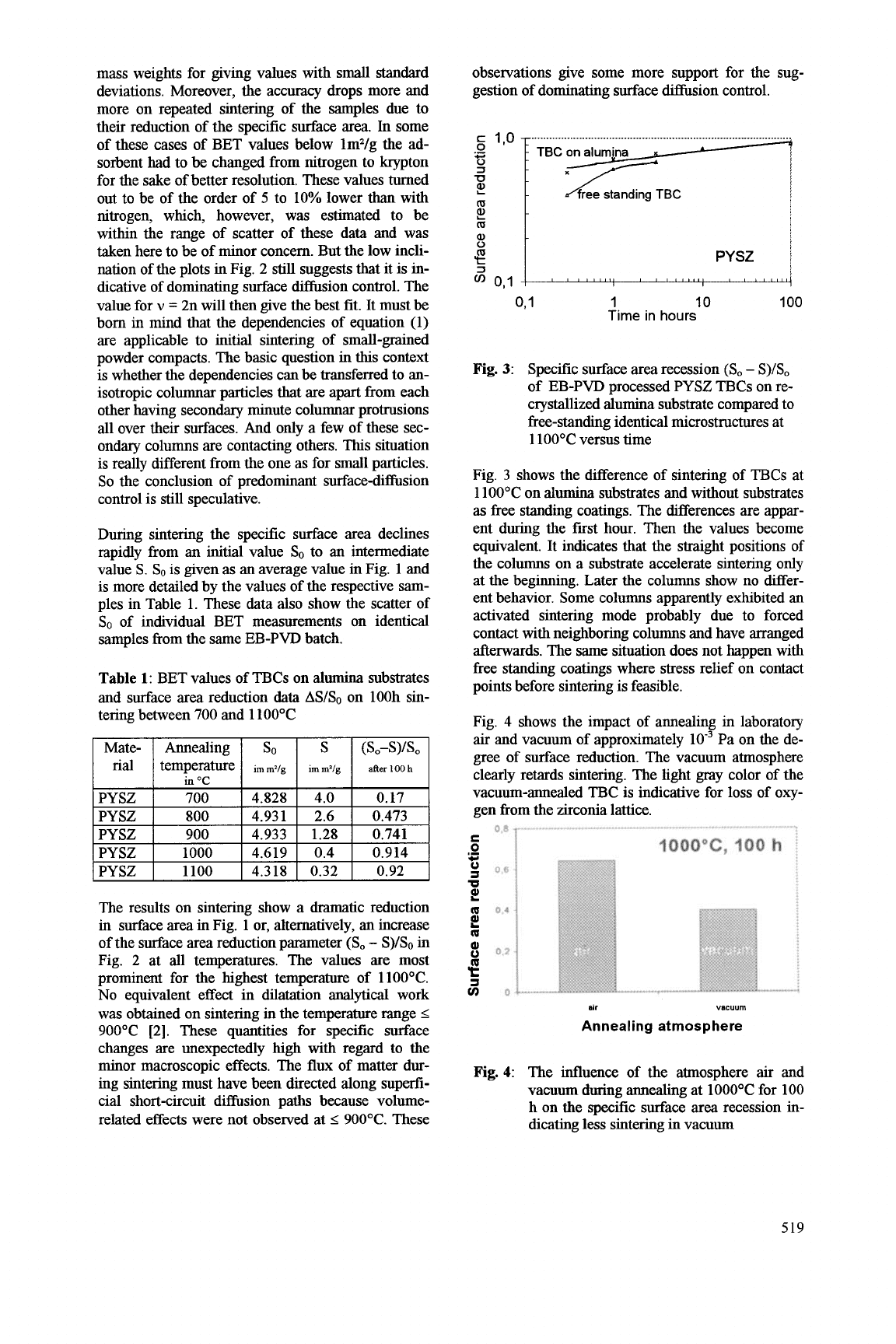
mass weights for giving values with
small
standard
deviations. Moreover, the accuracy drops more and
more on repeated sintering of the samples due to
their reduction of the specific surface area.
In
some
of these cases of BET values below 1mVg the ad-
sorbent had to be changed from nitrogen to krypton
for the sake of better resolution. These values turned
out to be of the order of
5
to 10% lower
than
with
nitrogen, which, however, was estimated to be
within the range of scatter of these data and was
taken here to be of minor concern. But the low incli-
nation of the plots in Fig. 2 still suggests
that
it
is
in-
dicative of dominating surface diffusion control. The
value for
v
=
2n will then give the best fit. It must be
born in mind that the dependencies of equation (1)
are applicable to initial sintering of small-grained
powder compacts. The basic question in
this
context
is whether the dependencies can be transferred to an-
isotropic columnar particles that are apart from each
other having secondary minute columnar protrusions
all over their surfaces. And only
a
few of these sec-
ondary columns are contacting others.
This
situation
is really different from the one as for small particles.
So
the conclusion of predominant surface-dfision
control is still speculative.
Mate- Annealing
So
s
rial temperature
im
mz/g
im
mz/g
During sintering the specific surface area declines
rapidly from an initial value
So
to an intermediate
value
S.
So
is given as an average value in Fig. 1 and
is more detailed by the values of the respective
sam-
ples in Table 1. These
data
also show the scatter of
So
of individual BET measurements on identical
samples from the same EB-PVD batch.
(s"-s)/s"
after
100
h
PYSZ
PYSZ 1000 4.619 0.914
PYSZ
1100
0
92
The results on sintering show a dramatic reduction
in surface area in Fig. 1 or, alternatively, an increase
of the surface area reduction pamneter
(So
-
S)/So
in
Fig. 2 at
all
temperatures. The values are most
prominent for the highest temperature of 1100°C.
No
equivalent effect in dilatation analytical work
was obtained on sintering in the temperature range
2
900°C [2]. These quantities for specific surface
changes are unexpectedly high with regard to the
minor macroscopic effects. The flux of matter dur-
ing sintering must have been directed along superfi-
cial short-circuit diffusion paths because volume-
related effects were not observed at
<
900°C. These
observations give some more support for the sug-
gestion of dominating surface diffusion control.
.-
TBC
on alumina
j
.
. . . . . . . . . . . . . . .
.
. .
.
. . . . . . . . . . . . . . . . . . . . . . . .
. . . .
.
I
L
mI
1
10
100
Time
in
hours
0,1
Fig.
3:
Specific surface area recession
(So
-
S)/So
of EB-PVD processed PYSZ TBCs on re-
crystallized alumina substrate compared to
free-standing identical microstructures at
1 100°C versus time
Fig.
3
shows the difference of sintering of
TBCs
at
1100°C on
alumina
substrates and without substrates
as
free standing coatings. The differences are appar-
ent during the first hour. Then the values become
equivalent. It indicates that the straight positions of
the columns on a substrate accelerate sintering only
at the beginning. Later the columns show no differ-
ent behavior. Some columns apparently exhibited an
activated sintering mode probably due to forced
contact
with
neighboring columns and have arranged
afterwards. The same situation does not happen with
free standing coatings where stress relief on contact
points before sintering
is
feasible.
Fig. 4 shows the impact of annealing in laboratory
air
and vacuum of approximately Pa on the de-
gree of surface reduction. The vacuum atmosphere
clearly retards sintering. The light gray color of the
vacuum-annealed TBC is indicative for loss of
oxy-
gen &om the zirconia lattice.
c
1000°C,
100
h
air
vacuum
Annealing atmosphere
Fig.
4:
The influence of the atmosphere
air
and
vacuum during annealing at 1000°C for 100
h on the specific surface area recession in-
dicating less sintering in vacuum
519
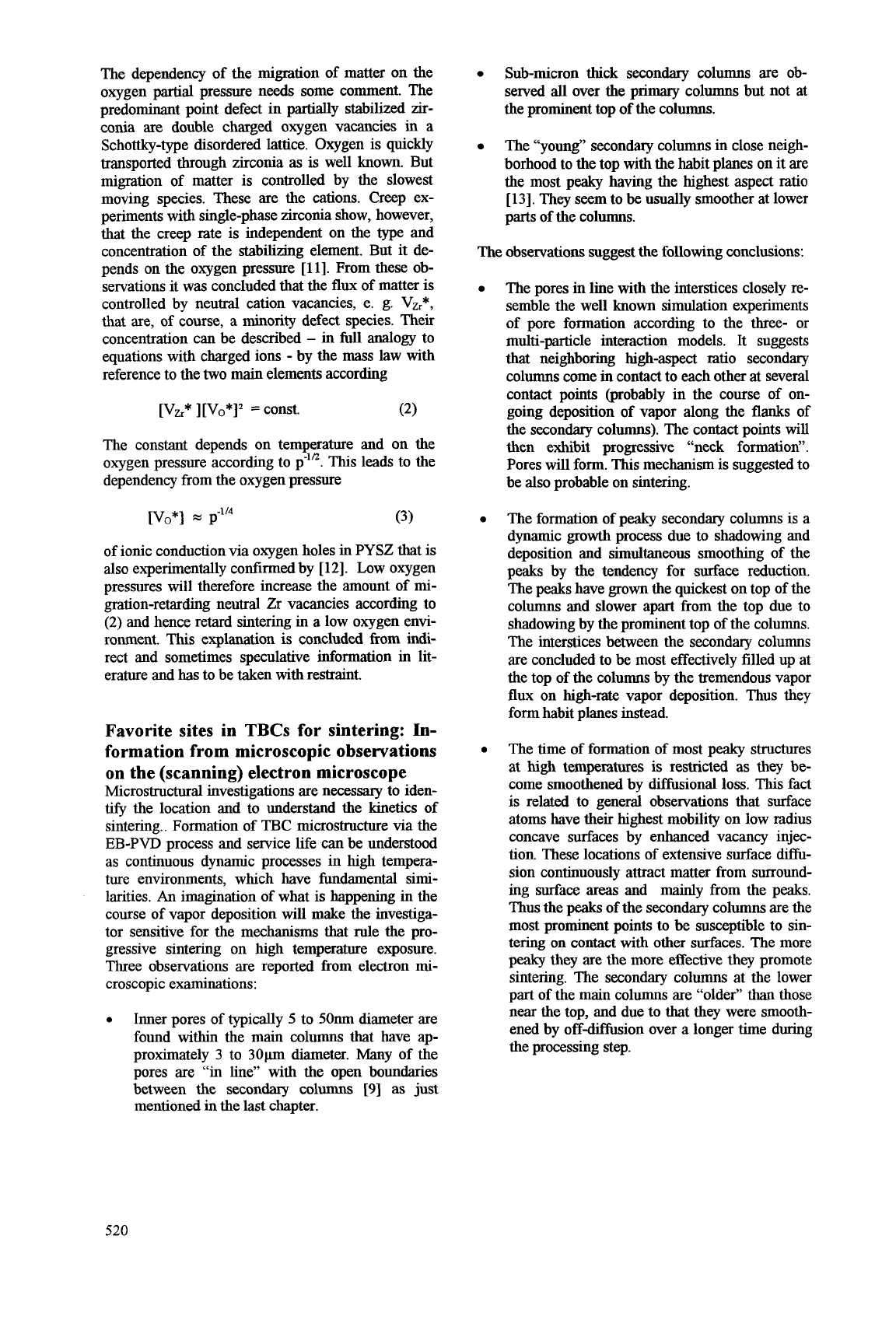
The dependency of the migration of matter on the
oxygen
partial
pressure needs some comment. The
predominant point defect in partially stabilized
zir-
mnia are double charged oxygen vacancies
in
a
Schottky-type disordered lattice. Oxygen is quickly
transported through zirconia
as
is
well
known.
But
migration of matter is controlled by the slowest
moving species. These are the cations. Creep ex-
periments with single-phase zirconia show, however,
that the creep rate is independent on the type and
concentration of the stabilizing element. But
it
de-
pends on the oxygen pressure
[
1
ll. From these ob-
servations
it
was concluded that the
flux
of matter is
controlled by neutral cation vacancies, e.
g.
VZr*,
that are,
of
course, a minority defect species. Their
concentration can be described
-
in
full
analogy
to
equations with charged ions
-
by the
mass
law with
reference to the two
main
elements according
[V,,*
3
[V0*]2
=
const.
(2)
The constant depends on temperature and on the
oxygen pressure according to p-ln.
This
leads to the
dependency from the oxygen pressure
[V0*]
EI
p-“4
(3)
of
ionic conduction via oxygen holes in
PYSZ
that is
also experimentally confirmed by
[
121. Low oxygen
pressures will therefore increase the amount of
mi-
gration-retarding neutral Zr vacancies according to
(2)
and hence retard sintering in a low oxygen envi-
ronment.
This
explanation is concluded from indi-
rect and sometimes speculative information in lit-
erature and has to be taken with restraint.
Favorite sites in
TBCs
for sintering:
In-
formation from microscopic observations
on the (scanning) electron microscope
Microstructural investigations are necessary to iden-
@
the location and to understand the kinetics of
sintering.. Formation of
TBC
microstructure via the
EB-PVD process and service life can be understood
as continuous dynamic processes in high tempera-
ture environments, which have fundamental
simi-
larities.
An
imagination of what is happening in the
course of vapor deposition
will
make the investiga-
tor sensitive for the mechanisms that rule the pro-
gressive sintering on high temperature exposure.
Three observations are reported from electron
mi-
croscopic examinations:
0
Inner pores of typically
5
to
50nm
diameter are
found within the main columns that have ap-
proximately
3
to
30pm
diameter. Many of the
pores are “in line” with the open boundaries
between the secondary columns
[9]
as just
mentioned in the last chapter.
0
Sub-micron thick secondary columns are ob-
served
all
over the primary columns but not at
the prominent top
of
the columns.
0
The “young” secondary columns in close neigh-
borhood
to
the top with the habit planes on it are
the most peaky having the highest aspect ratio
[
131. They seem to
be
usually smoother at lower
parts of the columns.
The observations suggest the following conclusions:
0
The pores in line with the interstices closely re-
semble the well
known
simulation experiments
of pore formation according to the three- or
multi-particle interaction models. It suggests
that neighboring high-aspect ratio secondary
columns come in contact
to
each other at several
contact points (probably in the course of on-
going deposition of vapor along the
flanks
of
the secondary columns). The contact points will
then exhibit progressive “neck formation”.
Pores will form.
This
mechanism is suggested to
be also probable
on
sintering.
0
The formation
of
peaky secondary columns is a
dynamic
growth
process due to shadowing and
deposition and simultaneous smoothing of the
peaks by the tendency for surface reduction.
The peaks have
grown
the quickest on top of the
columns and slower apart from the top due to
shadowing by the prominent top of the columns.
The interstices between the secondary columns
are concluded to be most effectively filled up at
the top of the columns by the tremendous vapor
flux
on high-rate vapor deposition. Thus they
form habit planes instead.
0
The time of formation
of
most peaky structures
at high temperatures is restricted as they be-
come smoothened by diffusional loss. This fact
is related to general observations that surface
atoms have their highest mobility on low radius
concave surfaces by enhanced vacancy injec-
tion. These locations of extensive surface diffu-
sion continuously attract matter from surround-
ing surface
arm
and
mainly from the peaks.
Thus the
peaks
of the secondary columns are the
most prominent points to be susceptible to sin-
tering
on
contact with
other
surfaces. The more
peaky they are the more effective they promote
sintering. The secondary columns at the lower
part
of
the main columns are “older”
than
those
near the top, and due to that they were smooth-
ened by off-diffusion over a longer time during
the processing
step.
520
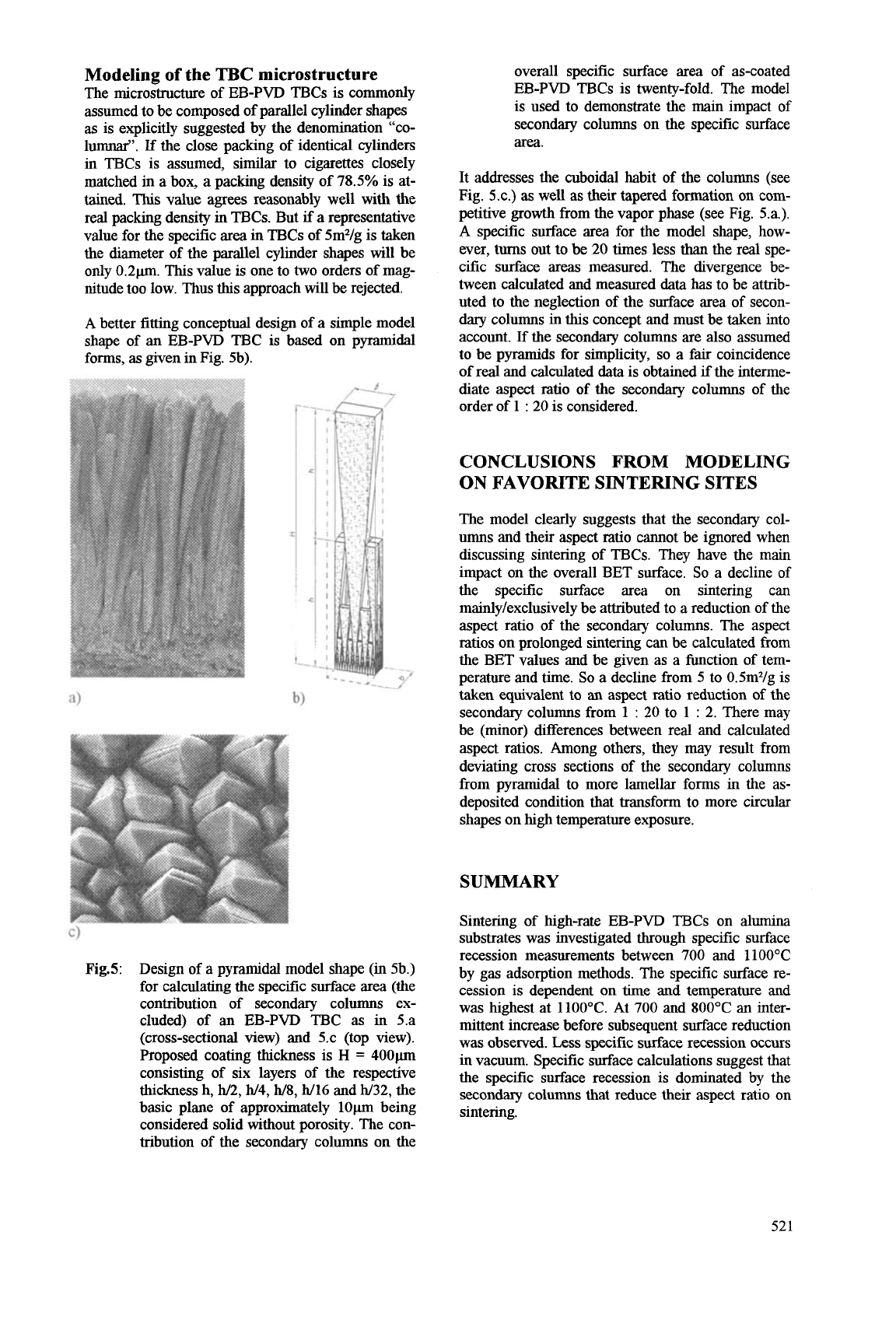
Modeling
of
the TBC microstructure
The microstructure of EB-PVD TBCs is commonly
assumed to be composed of parallel cylinder shapes
as
is explicitly suggested by the denomination "co-
lumnar".
If
the close paclung of identical cylinders
in TBCs is assumed, similar to cigarettes closely
matched in a box, a paclung density of
78.5%
is at-
tained.
Ths
value agrees reasonably well
with
the
real packing density in TBCs. But
if
a representative
value for the specific area in TBCs of 5mz/g
is
taken
the diameter
of
the parallel cylinder shapes
will
be
only 0.2~.
This
value is one to two orders of
mag-
nitude too low. Thus
this
approach will be rejected.
A
better fitting conceptual design of a simple model
shape of an EB-PVD
TBC
is based on
pyramidal
forms,
as
given in Fig. 5b).
Fig.5:
Design of a pyramidal model shape (in 5b.)
for calculating the specific surface area (the
contribution of secondary columns ex-
cluded) of an EB-PVD TBC
as
in 5.a
(cross-sectional view) and 5.c (top view).
Proposed coating thickness is
H
=
400p.m
consisting of six layers of the respective
thickness h, N2,
W4,
N8, N16 and N32, the
basic plane of approximately
lOpm
being
considered solid without porosity. The con-
tribution of the secondary columns on the
overall specific surface area of as-coated
EB-PVD TBCs
is
twenty-fold. The model
is used to demonstrate the main impact
of
secondary columns on the specific surface
area.
It addresses the cuboidal habit of the columns (see
Fig. 5.c.)
as
well
as their tapered formation on com-
petitive growth from the vapor phase (see Fig. 5.a.).
A
specific surface area for the model shape, how-
ever,
turns
out to be
20
times less
than
the real spe-
cific surface areas measured. The divergence be-
tween calculated and measured data has to be attrib-
uted to the neglection of the surface area of secon-
dary columns in
this
concept and must be taken into
account.
If
the secondary columns are also assumed
to be pyramids for simplicity,
so
a fair coincidence
of real and calculated
data
is obtained
if
the interme-
diate aspect ratio of the secondary columns of the
order
of
1
:
20 is considered.
CONCLUSIONS FROM MODELING
ON FAVORITE SINTERING SITES
The model clearly suggests that the secondary col-
umns and their aspect ratio cannot be ignored when
discussing sintering of TBCs. They have the main
impact on the overall BET surface.
So
a decline of
the specific surface area on sintering can
mainly/exclusively be attributed to a reduction of the
aspect ratio of the secondary columns. The aspect
ratios on prolonged sintering can be calculated
from
the BET values and be given as a function of tem-
perature and time.
So
a decline from
5
to 0.5m2/g is
taken equivalent to
an
aspect ratio reduction of the
secondary columns from
1
:
20
to 1
:
2. There may
be (minor) dfierences between real and calculated
aspect ratios. Among others, they may result from
deviating cross sections
of
the secondary columns
from pyramidal to more lamellar forms in the as-
deposited condition that transform to more circular
shapes on high temperature exposure.
SUMMARY
Sintering of high-rate EB-PVD TBCs on alumina
substrates was investigated through specific surface
recession measurements between
700
and 1100°C
by
gas
adsorption methods. The specific surface re-
cession is dependent on time and temperature and
was highest at
1100°C.
At
700
and
800°C
an inter-
mittent increase before subsequent surface reduction
was observed.
Less
specific surface recession occurs
in
vacuum. Specific surface calculations suggest that
the specific surface recession is dominated by the
secondary columns that reduce their aspect ratio on
sintering.
52
1
